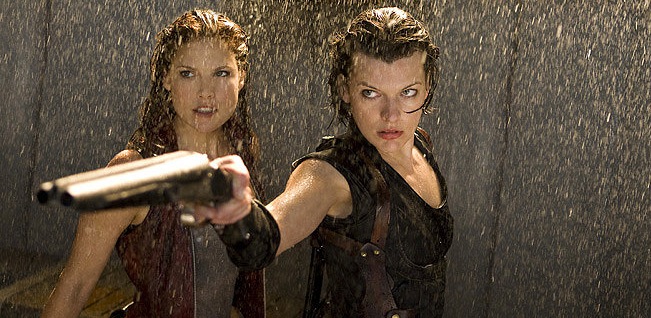The first Resident Evil is a fun little movie; it is full of zombies and brutal violence – what is there to not like about that? The second one, Apocalypse, was just OK. Nothing great. Nothing memorable. The third movie, Extinction, was terribly boring. Nothing exciting ever happened. Every kill was the same unoriginal violent act. But the new fourth installment to the franchise is something else. Considering it was directed by Paul W.S. Anderson (Death Race), who directed the first Resident Evil, it is no surprise that Afterlife is the best Resident Evil picture since the first.
After quickly recapping the outbreak in Japan, Afterlife opens with a long stylized action sequence that shows off Alice (Milla Jovovich, The Fourth Kind) and all of her genetic powers. She and her clone army break into the Tokyo compound of the evil Umbrella corporation that caused the virus’ outbreak, destroying everything as they go through gravity defying action.
During a quick exit of the compound, Alice comes face-to-face with a new-and-improved genetically enhanced super soldier. During their confrontation, Alice is injected with a serum that undoes her genetic enhancements, making her “human” again.
After six months of flying around searching for her friends that were introduced in Extinction (don’t worry, you don’t need to have seen Extinction to see Afterlife – everything important from that movie is recapped through flashbacks), Alice finally comes across a feisty amnesiac Claire (Ali Larter, canceled telelvision series Heroes). After trying her up and loading her in her plane, Alice heads down the Pacific coast of the U.S. in search of survivors.
While passing over always-foggy Los Angeles (who knew that zombies cause endless fog?), Alice notices “HELP” painted on the roof of a huge prison completely surrounded by thousands of zombies. After an exciting crash-landing on the roof, Alice meets a group of trapped Hollywood “celebrities.” As Claire begins to recall the events that happened prior to Alice’s arrival, those memories and the facts that their new prison dwelling friends have collected spark a hope-inspiring goal of survival – all they have to do is get out of this surrounded prison.
The story of Afterlife is not the greatest, but still better than the others. To up the ante of action it unexplainably introduces us to new forms of zombies – giant, somewhat intelligent zombies and quick-swimming freshwater zombies. Both make for fun action sequences.
Although the action elements of Afterlife are not completely original – a huge chunk of it is stolen from The Matrix – it is still very entertaining to watch. (Even the robot-like bad guy’s performance is an over-the-top exaggeration of Hugo Weaving’s Mr. Smith from The Matrix). For anyone who enjoys girl-power action, this movie is golden.
Afterlife was filmed in 3-D, not transferred to 3-D. Although it in not quite Avatar 3-D, if is still bounds above the poor transfers to 3-D The Last Airbender and Clash of the Titans. Afterlife 3-D is worth the extra two bucks.
Of course, Afterlife ends with a cliffhanger – one that feels like it would segue more into a video game than another movie. Nonetheless, Afterlife is an above par Resident Evil flick. It is fun, action-packed, styled and violent. If you have enjoyed the previous Resident Evil movies, then there is not reason why would won’t enjoy Afterlife.
Photo credit: Screen Gems










